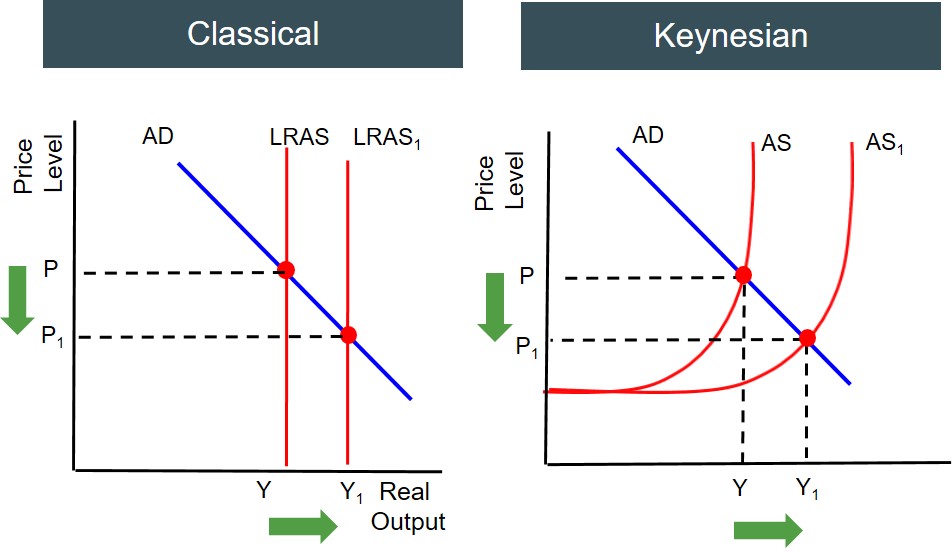Initiatives that are intended to increase the economy's ability to produce goods and supply goods and services by creating incentives for economic agents to work, save, invest and be entrepreneurial i.e. increase the productive capacity of the economy.
The type of supply side policies implemented depends on the economic school of thought policymakers belong to. There are two types:
- Free Marketeer
- Interventionist
These initiatives if implemented in the economy, will create an expansion in the supply curve in the long-run, from a classical perspective this will be an outwards LRAS curve shift and in the Keynesian case it will be an expansion in the Keynesian aggregate supply curve.

Assuming ceteris paribus, from both economic schools of thought the impact on the macroeconomic equilibrium will be for the price level to fall (inflation decelerates) and real output to increase.
These policies will help the government achieve some of their macroeconomic objectives in the long-run. Inflation will be lower as the economy becomes more efficient and productive and this helps drive costs down. Deregulation is an example of a supply side policy which can help remove constraining regulations on firms, reducing their costs. The lower costs incentivise firms to produce more and eventually these get passed onto consumers. Hence the reduced inflationary pressures in the long-run
Economic growth becomes sustainable as there is an increase in the productive capacity of the economy, which means resources do not become stretched despite higher output. For instance, privatisation can increase the size of the private sector and this will increase the level of entrepreneurial activity in the economy. This enterprise fuels hgreater economic activity without the onset of inflationary pressures.
Unemployment is reduced as supply side policies can help remove labour market frictions and also improve the level of labour mobility in the economy. For instance, a policy to increase spending in education and training to improve skills and flexibility, will lead to long-run gains in labour productivity, which ultimately makes workers more valuable to employers. These policies in the long-run help to reduce the natural rate of unemployment.
It is important to also consider the impact that supply side policies have on the current account on the balance of payments for a country. If the economy increases its productive capacity, the lower price level will increase the competitiveness of a country's exports and this in turn should lead to an improvement in the current account position of a country. But this is subject to a few other factors such as: relative inflation rate with other countries, PED of imports and exports and the significance of the decelerating inflation rate.
However, as with the case of other economic policies, the impact and effectiveness of supply side policies on the real economy is not always an exact science. So you need to be able to evaluate these policies when dealing with an exam answer. The evaluation points around supply side policies relate to:
- Magnitude and duration of impact?
- Timing of impact?
- Certainty of impact?
- Ease of administration?
- Equality impact?
For instance, certain supply side policies can involve significant time lags and therefore the duration and timing of the impact can depend on the type of policy implemented. For example, policies targeted towards education and training - which aim to increase the level of human capital - are likely to take 10-15 years to feed through benefits to the economy and therefore unemployment may not be significantly affected.
Also, supply side policies can be difficult for the economy to implement compared to a conventional monetary policy, in which a decision to change interest rates can be made monthly.
Supply side policies can also have an adverse impact on the distribution of income and wealth because these policies can create a greater divergence between the wealthiest and poorest individuals.
Therefore, as a result of some of these uncertainties, supply side policies are normally used to complement demand side economic policies (monetary and fiscal policies) to reach the desired outcome of the government i.e. sustainable economic growth.